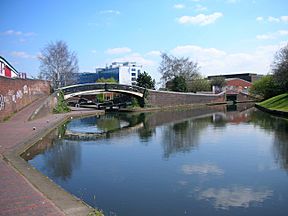Aston Junction facts for kids
Aston Junction is a busy spot where two important canals meet in Birmingham, England. It's where the Digbeth Branch Canal joins the Birmingham and Fazeley Canal. Imagine it like a crossroads for canal boats!
Contents
History of Aston Junction
Building the Canals
The Birmingham and Fazeley Canal was given permission to be built in 1784. This permission came from a special law called an Act of Parliament. The canal company made sure it would connect to other major canals. These included the Oxford Canal, the Coventry Canal, and the Trent and Mersey Canal.
The goal was to create a big network of waterways. This network would allow boats to carry goods all the way to London. The main part of the Birmingham and Fazeley Canal was finished in 1789. It ran from Farmers Bridge Junction in Birmingham to Fazeley. The connecting canals were ready by the next year.
Joining Forces
Soon after, the Birmingham and Fazeley Canal company teamed up with the Birmingham Canal company. Together, they became known as the Birmingham Canal Navigations.
The Digbeth Branch Canal was built later, in 1799. It joined the main Birmingham and Fazeley line right here at Aston Junction. This branch was quite short and had six locks. It ended at a place called Typhoo Basin. Near the end of this branch, another canal joined it: the Warwick and Birmingham Canal. This canal later became part of the Grand Union Canal.
Dealing with Traffic
Aston Junction became a very busy place. It was the main way for boats to travel between the Birmingham Canal network and the route to London. No matter which way boats wanted to go from the junction, they had to go through a series of locks. Locks are like water elevators that help boats move up or down hills.
People started looking for ways to make things less crowded. In 1844, a new canal opened called the Tame Valley Canal. This new canal helped a lot! It gave boats a way to avoid some of the busiest lock systems. Boats could now skip the eleven locks of the Aston flight and the six locks of the Ashted flight. Instead, the new Garrison flight had only five locks. This made travel much smoother and faster.
Location of Aston Junction
From Aston Junction, the Birmingham and Fazeley Canal goes in two main directions:
- South-west: It goes uphill through 13 locks called the Farmers Bridge locks. These locks lift boats about 81 feet (25 meters). This part of the canal is about 1.3 miles (2.1 kilometers) long. It leads to Farmers Bridge Junction.
- North-east: It goes downhill through eleven locks called the Aston flight. These locks lead to Salford Junction, which is about 1.8 miles (2.9 kilometers) away. At Salford Junction, the Tame Valley Canal and the Grand Union Canal also join.
The Digbeth Branch Canal heads south-east from Aston Junction. It is quite short, only about 0.9 miles (1.4 kilometers) long. Its end point, Typhoo Basin, is also known as Digbeth Basin or Bordesley Basin.
Aston Junction is special because it has two bridges for the same lock. One bridge is made of iron and was built by Horseley Ironworks. The other bridge, at the bottom of the lock, is made of brick.


